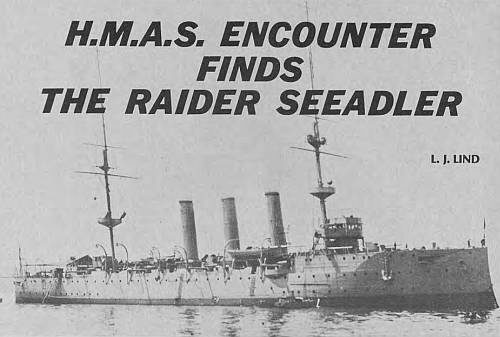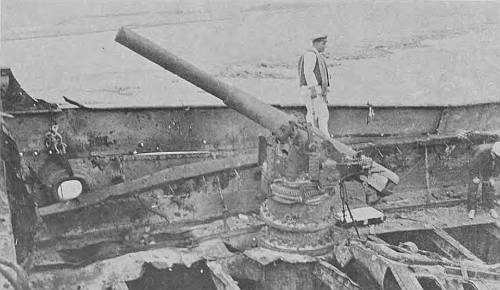- Author
- A.N. Other and NHSA Webmaster
- Subjects
- Ship histories and stories
- Tags
-
- RAN Ships
- HMAS Encounter I
- Publication
- June 1974 edition of the Naval Historical Review (all rights reserved)
The story of the raider Seeadler has been told many times yet still thrills all who read of her audacity. In this article the disarming of the raider’s gutted hulk is related. Chief Petty Officer Stidson, from whose diary the facts were extracted is still hale and hearty and living at Quakers Hill near Sydney.

PERHAPS NOT THE MOST SUCCESSFUL but certainly the most flamboyant of the German raiders to operate in the Indian and Pacific Oceans in World War I was Count Felix von Luckner’s Seeadler. Von Luckner had previously served in the raider Moewe during her successful cruise and on his return to Germany was given permission to outfit a raider himself.
He chose the captured British sailing ship Pass of Bahama which he had fitted with two 1,200 hp diesel engines. Her armament consisted of two 4 inch guns, two torpedo tubes and a good supply of machine-guns and small arms.
Seeadler slipped through the tight British blockade on 21st December 1916 disguised as a Norwegian timber ship, and sailed south to the good hunting grounds between Brazil and West Africa. Victims were not difficult to locate and in four weeks he caught 13 vessels. Included in the bag were three large British vessels, two British sailing ships carrying wheat from Australia, a Canadian schooner, five French sailing ships and an Italian and a Dane.
The ‘hunting grounds’ became unsafe when British cruisers were despatched to the area to investigate the disappearance of the vessels, and von Luckner sailed south round Cape Horn and entered the Pacific.
Luck was not to accompany him into the new area of operations. He scouted the length of the South American coast without sinking a single vessel and then sailed west to the Galapagos Islands. In these waters he captured three US sailing ships bound for Sydney but unfortunately he botched the sinking of one, which left a trail of wreckage which was soon reported. Every Allied warship in the Pacific was alerted to the presence of an enemy raider.
Von Luckner intercepted the increased wireless traffic that followed the alert and decided to hide-up in the Society Group. He arrived at the little island of Mopelia on 1st August and the next morning disaster struck. A sudden squall drove Seeadler onto a reef.
It was soon apparent the vessel was doomed and all boats and stores were moved ashore. When Seeadler was stripped she was fired and allowed to burn down to the waterline.
The raider’s captain, with two officers and three sailors, set out in the ship’s launch for Fiji on 21st August with the intention of seizing another vessel. However, luck was not with him and at Wakaya, von Luckner and his companions were captured by the coastal steamer Amra, manned by a party of Fijian police. The balance of Seeadler’s crew succeeded in capturing the French vessel Lutece and made their way to neutral Chile. Von Luckner was later taken to New Zealand as a prisoner of war.

In November HMAS Encounter was ordered to Mopelia to examine the wreck of the raider and CPO Ernest Stidston recorded the visit in his diary.
‘9th November 1917: 1000 HMAS Encounter arrived Mopelia Island. We could see the German raider Seeadler on the reef between two islands. She had been set on fire before being abandoned and was practically gutted. Officers and men went aboard and found two 4.1 in. guns intact, and some ammunition which had escaped the fire.
Through glasses, huts could be seen on the Island. Commander Wilmot, the Chaplain and Sub Lieutenant Harris set out to search the settlement which the Germans had built. They found a considerable amount of stores, enough to last some time.
November 10th: A working party under Engineer Commander Brand and Lieutenant Commander Matheson boarded Seeadler and brought off one 4.1 in. gun and miscellaneous ship’s gear.
November 11th: 0600 A party went aboard the ship and put a charge (of explosive) in the remaining gun mounting and destroyed it.
0900 We sailed for Tahiti, 260 miles away.
November 14th: 2200. Our steam pinnace on returning from shore (Tahiti) collided with an auxiliary yacht and sank in a few minutes. Fortunately there was no loss of life.’




